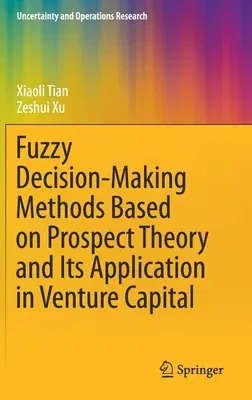Preface 1
Chapter 1. Introduction 1
1.1 Background 1
1.1.1 Development of bounded rationality 2
1.1.2 Development of fuzzy information 3
1.1.3 Importance of research about fuzzy decision making with prospect
theory 3
1.2 Corresponding preliminaries 4
1.2.1 Prospect theory 5
1.2.2 TODIM 5
1.2.3 Intuitionistic fuzzy information 7
1.2.4 Probabilistic hesitant fuzzy information 9
1.2.5 Hesitant fuzzy linguistic information 11
1.2.6 Probabilistic linguistic information 14
1.3 Aim and focus of this book 17
Chapter 2. Intuitionistic Fuzzy MADM based on PT 19
2.1 Decision-making procedure 20
2.2 Illustrative example 24
2.2.1 Decision-making attributes used by VCs 26
2.2.2 Selecting process and results derived by IFPT 28
2.2.3. Selecting process and results derived by TOPSIS 30
2.3. Remarks 33
Chapter 3. QUALIFLEX based on PT with Probabilistic Linguistic
Information 35
3.1 Procedure of P-QUALIFLEX with probabilistic linguistic information
36
3.2 Procedure of the extended QUALIFLEX with probabilistic linguistic
information 39
3.3 Illustrative example 41
3.3.1 Results of P-QUALIFLEX with probabilistic linguistic information
42
3.3.2 Results of the extended QUALIFLEX with probabilistic linguistic
information 46
3.4 Comparative analysis 48
3.4.1 Comparison of P-QUALIFLEX with extended QUALIFLEX 48
3.4.2 Comparison of P-QUALIFLEX with TODIM 50
3.5 Remarks 55
Chapter 4. Group PROMETHEE based on PT with Hesitant Fuzzy Linguistic
Information 57
4.1 GP-PROMETHEE with hesitant fuzzy linguistic information 60
4.2 G-PROMETHEE with hesitant fuzzy linguistic information 65
4.3 Illustrative example 67
4.3.1 Decision-making background 67
4.3.2 Results of the GP-PROMETHEE with hesitant fuzzy linguistic
information 69
4.3.3 Results of the G-PROMETHEE with hesitant fuzzy linguistic
information 75
4.3.4 Results of TODIM with hesitant fuzzy linguistic information 78
4.3.5 Comparative analysis 80
4.3.5.1 Comparative analysis based on the results of illustrative
example 81
4.3.5.2 Comparative analysis based on the sensitivity of parameters 82
4.4 Simulation analysis 88
4.5 Remarks 91
Chapter 5. Prospect Consensus with Probabilistic Hesitant Fuzzy
Preference Information

